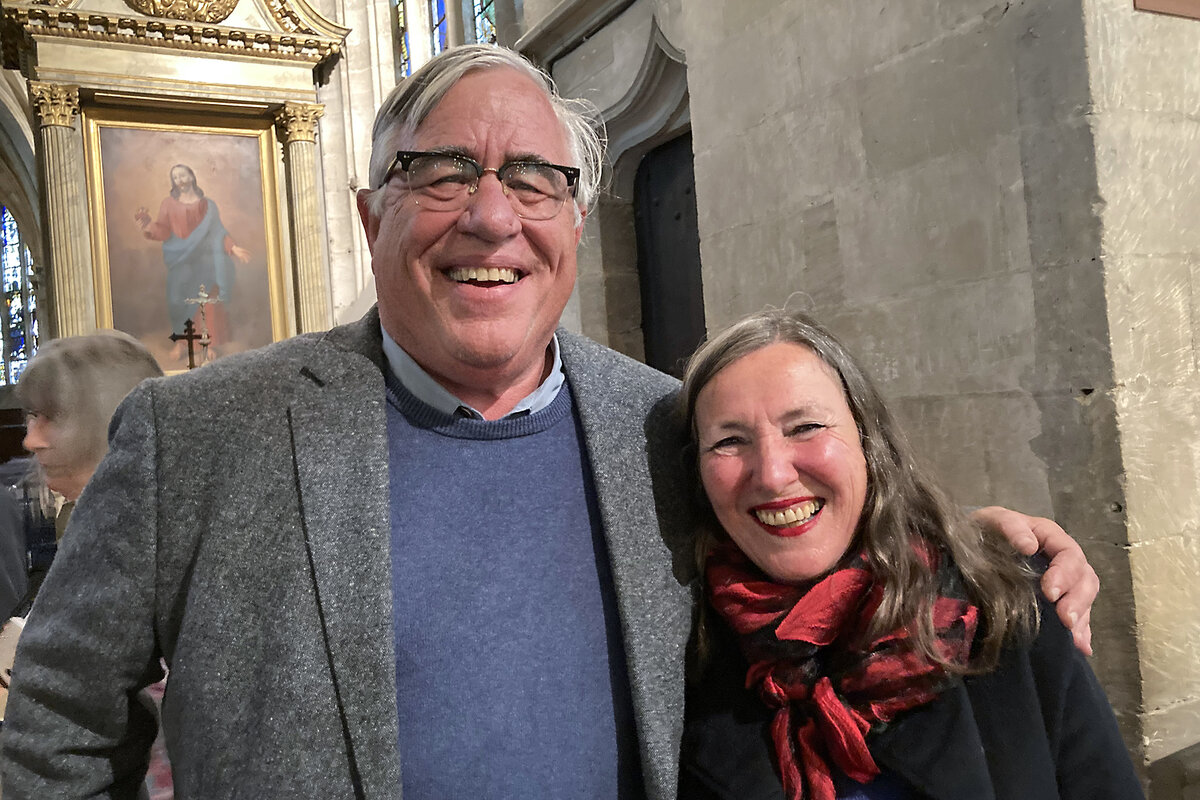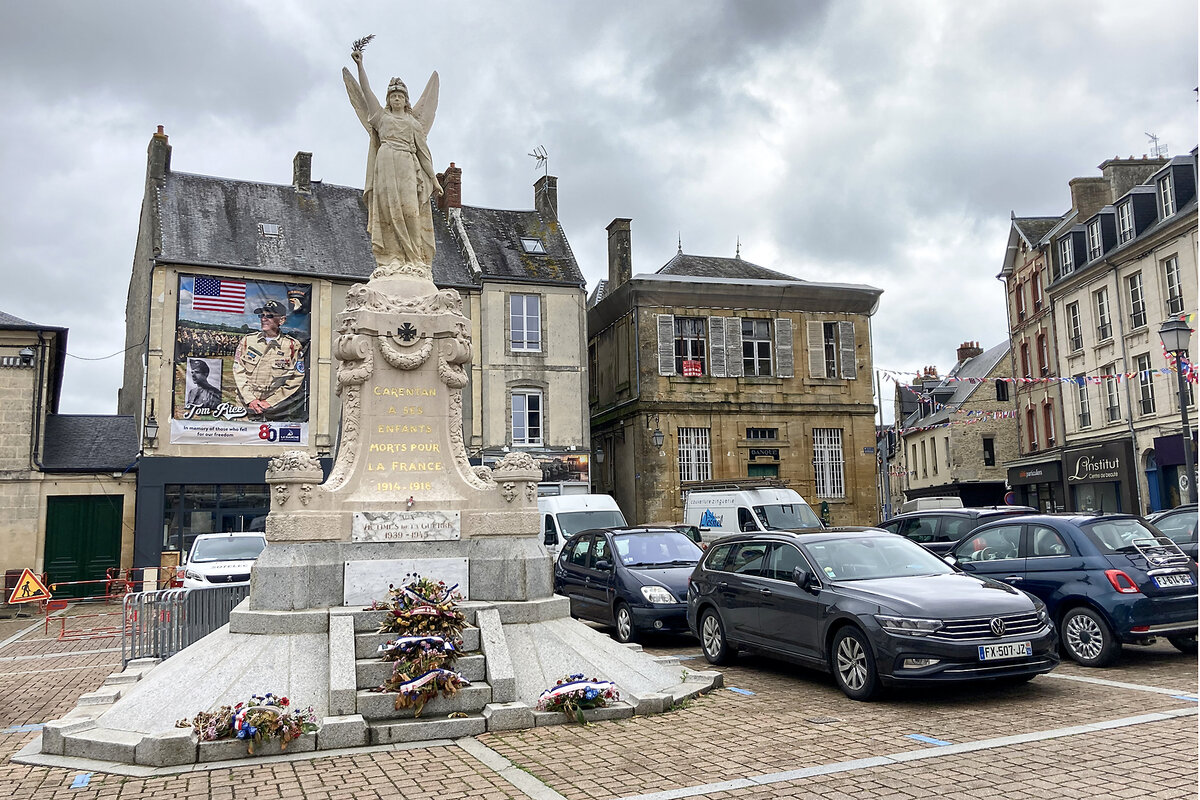On D-Day’s 80th anniversary, volunteers knit for victory with ‘The Longest Yarn’
Loading...
| Carentan-les-Marais, France
On June 6, 1944, Harry Kulkowitz had just pushed out onto Utah Beach with the 114th Signal Battalion when he found himself crouching behind a low hedge. When he heard murmuring, he assumed it was an enemy soldier and shot into the dark. The voice went silent.
It was only the next morning that Mr. Kulkowitz realized he had killed a cow.
As a vacation rental operator, British native Tansy Forster was sometimes privy to war stories like these. In 2004, Mr. Kulkowitz and his son Mark stayed in her Normandy home. They continued to come every year until Harry Kulkowitz’s death in 2017. But, Ms. Forster says, “most veterans didn’t want to talk about the war.”
Why We Wrote This
A story focused onD-Day will be commemorated by fireworks, speeches, flowers, tears ... and yarn. An international effort – done entirely by volunteers – is a lesson in the power of community to build understanding.
For the 80th anniversary of the D-Day landings, Ms. Forster wanted to honor the experiences of people like Mr. Kulkowitz, as well as her uncle, who was killed in World War II. Her idea? Knitting woolly postbox toppers, popular in the United Kingdom, in the shape of soldiers and tanks.
“Then someone said, ‘Why don’t you do 80 for the 80th anniversary?’” says Ms. Forster, from the Notre-Dame Church in Carentan-les-Marais. “The idea just got bigger and bigger.”
The result is 80 meters (88 yards) of 80 3D panels of knitted and crocheted scenes of the D-Day invasion. Ms. Forster enlisted over 1,000 knitters via Facebook from the U.K., the United States, Australia, and New Zealand to complete the 3D tapestry. It will be on display in the Normandy church before moving to Great Britain in September and, eventually, Cape May, New Jersey – home to Harry Kulkowitz’s son, Mark.
Called “The Longest Yarn,” a nod to the 1962 war film “The Longest Day,” the exhibit seeks to tell the stories that veterans either struggle with or are no longer alive to tell. The international effort – done entirely by volunteers – is a lesson in the power of community to build understanding.
“We need to continue commemorating D-Day, even fictionally. The important thing is to show the truth,” says Olivier Wieviorka, a French historian who specializes in World War II. “Sharing these moments with others, having a common history, is what truly brings us together as a nation.”
Where D-Day is never far away
More than 150,000 troops descended on the Normandy beaches on June 6, 1944, to liberate German-occupied Western Europe. The D-Day operation, which brought together land, sea, and air forces from the allied armies, is considered the largest seaborne invasion in military history. Over 10,000 soldiers perished.
While D-Day is, for many, relegated to history books, the events of June 6 are never far from residents of Carentan-les-Marais. A war-era parachute billows from the ceiling of a local café and American military uniforms, helmets, and other World War II memorabilia sell year-round in souvenir shops. In one store window sits a copy of Gen. Charles de Gaulle’s 1940 message to the French people: France may have lost a battle, but France hasn’t lost the war!
Paulette Mesnilgrente was only 11 years old when U.S. soldiers helped liberate France from German control. Now in her 90s, she remembers people taking to the streets of her hometown, Houesville, waving flags in celebration.
“The soldiers would bring us gum and candy,” says Ms. Mesnilgrente. “To this day, I still have very fond memories of the Americans.”
Just before France’s liberation, someone snapped a photo of Ms. Mesnilgrente and her siblings with four American soldiers, which somehow made it back to her years later. Now, that moment in history is represented in panel No. 78 of “The Longest Yarn.”
Historical accuracy has been a significant part of the project, says Ms. Forster, who got help from a historian to verify military uniforms, colors, and insignia. But volunteer knitters did much of the research themselves.
“I never learned this stuff in school so I wanted to make things as accurate as possible,” says Jenny Shepperd, who traveled from Basingstoke, England, to see “The Longest Yarn” in person at the end of May. She and school friend Diana Peacock crocheted 55 soldiers, a military jeep, and a tank landing ship, and created a panel to honor Harry Kulkowitz. “As for the knitting, it was a lot of trial and error. I knew how to make sweaters, but not this!”
Ms. Shepperd leaned on her newfound virtual community to get tips on how to make the soldiers stand up straight or to share her own crocheting tricks. For knitters who lost family members in the war, the project has had a knock-on healing effect.
Knitting itself has documented therapeutic effects and can help heal trauma, says Dominique Kaehler Schweizer, also known as Madame Tricot (Mrs. Knitting), a Franco-Swiss psychiatrist and 3D knitting artist. “There is also something beautiful about participative projects and working with others. It’s good for your soul.”
How shared history can heal
While “The Longest Yarn” has built community for the 1,000-strong band of volunteers, it also aims to bring people together from around the world over a shared history.
For Germans visiting Normandy, the topic of D-Day – and World War II in general – remains fraught. But for Marcos Pansegrau, visiting “The Longest Yarn” is therapeutic. His uncle died in August 1944, but his mother refused to visit her brother’s grave in Normandy until 2011. Since then, Mr. Pansegrau has been coming regularly to stay in one of Ms. Forster’s rental properties, where he’s met numerous veterans and their families.
“We’ve come together as British, American, and German, sharing a drink. It’s always an emotional moment,” says Mr. Pansegrau. “This project is an excellent way to come into contact with the war.”
With events for the 80th anniversary taking place all week, Normandy is expecting millions of tourists from Belgium, Canada, the U.K., and the U.S. President Joe Biden will also attend the commemoration, making it his first state visit to France.
“D-Day is an important part of this town’s history,” says Mayor Jean-Pierre Lhonneur. “You can see it from the American flags waving in the streets to the war scenes depicted in the stained glass windows of the local church. We’re going to do everything we can to show off this exhibit and teach what happened.”
For Mark Kulkowitz, “The Longest Yarn” is proof that communities can unite in the most unlikely ways to contribute to a collective memory. When the exhibit makes its voyage to Cape May, it will be as if his father, Harry, who received the Legion of Honor in 2010, is coming home.
“My father fought in the war; my mother is a Holocaust survivor. It means so much to be able to share their stories,” says Mr. Kulkowitz. “This isn’t political. It’s about people who gave up their lives for freedom and to make the world a better place.”









